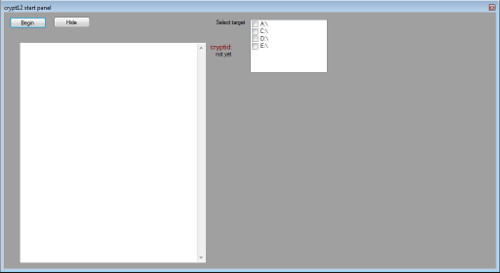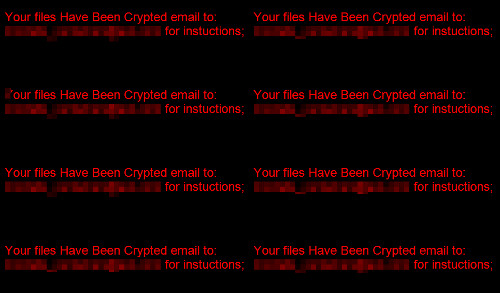RANSOM_CRYPTWELVE.A
Windows


Threat Type: Ransomware
Destructiveness: No
Encrypted: No
In the wild: Yes
OVERVIEW
Downloaded from the Internet, Dropped by other malware
This Ransomware arrives on a system as a file dropped by other malware or as a file downloaded unknowingly by users when visiting malicious sites.
TECHNICAL DETAILS
116,736 bytes
EXE
Yes
13 Aug 2017
Displays windows, Displays graphics/image, Encrypts files
Arrival Details
This Ransomware arrives on a system as a file dropped by other malware or as a file downloaded unknowingly by users when visiting malicious sites.
Installation
This Ransomware drops the following files:
- %Temp%\wallpaper.bmp
- %Desktop%\sys.bat <-used to terminate the ransomware
(Note: %Temp% is the Windows temporary folder, where it usually is C:\Windows\Temp on all Windows operating system versions.. %Desktop% is the desktop folder, where it usually is C:\Documents and Settings\{user name}\Desktop in Windows 2000, Windows Server 2003, and Windows XP (32- and 64-bit); C:\Users\{user name}\Desktop in Windows Vista (32- and 64-bit), Windows 7 (32- and 64-bit), Windows 8 (32- and 64-bit), Windows 8.1 (32- and 64-bit), Windows Server 2008, and Windows Server 2012.)
Other System Modifications
This Ransomware adds the following registry keys:
HKEY_CURRENT_USER\Control Panel\Desktop
Wallpaper = %Temp%\wallpaper.bmp
Ransomware Routine
This Ransomware avoids encrypting files with the following strings in their file name:
- .crypt12
- .tmp
- .sep
- .tlb
- .tbl
- .tsp
- .cmd
- .ax
- .olb
- .com
- .acm
- .edb
- .ini
- .exe
- .386
- .73u
- .8xu
- .adm
- .adml
- .admx
- .ani
- .ann
- .aos
- .asec
- .bio
- .bk2
- .blf
- .bmk
- .bud
- .cab
- .cdmp
- .chs
- .ci
- .cnt
- .cpi
- .cpl
- .cpq
- .cur
- .desklink
- .deskthemepack
- .dev
- .diagcab
- .diagcfg
- .diagpkg
- .dimax
- .dit
- .drv
- .dss
- .dyc
- .ebd
- .efi
- .evtx
- .ffa
- .ffl
- .ffo
- .ffx
- .ftg
- .fts
- .gmmp
- .grl
- .group
- .grp
- .h1s
- .hdmp
- .hhc
- .hhk
- .hiv
- .hlp
- .hpj
- .hsh
- .htt
- .icl
- .icns
- .ico
- .idi
- .ifw
- .ime
- .img3
- .inf_loc
- .ins
- .ion
- .ipod
- .itemdata-ms
- .its
- .jpn
- .kbd
- .key
- .kor
- .library-ms
- .lnk
- .log1
- .log2
- .lpd
- .manifest
- .mapimail
- .mdmp
- .mi4
- .mlc
- .mobileconfig
- .msc
- .msp
- .msstyle
- .msstyles
- .mui
- .mui_cccd5ae0
- .mum
- .mydocs
- .nb0
- .nbh
- .nfo
- .nls
- .nt
- .ntfs
- .p7b
- .pck
- .pdr
- .pfx
- .pid
- .pk2
- .pol
- .ppd
- .prefpane
- .prf
- .printerexport
- .ps2
- .pwl
- .rc1
- .rc2
- .rco
- .reg
- .regtrans-ms
- .rfw
- .rmt
- .rs
- .ruf
- .savedsearch
- .sbn
- .scap
- .scf
- .scr
- .shd
- .shsh
- .swp
- .sys
- .tdz
- .tha
- .theme
- .trx_dll
- .uce
- .vga
- .vgd
- .vx_
- .vxd
- .webpnp
- .wer
- .wph
- .wpx
- .xfb
- .xrm-ms
- .dat
- .db
- .dll
- .dmp
- .ics
- .mod
- .mpa
- .msu
- .nomedia
- .ocx
- .ps1
- .rom
- .rtp
- .shs
- .spl
- .themepack
- .0
- .000
- .amlv
- .automaticdestinations-ms
- .bashrc
- .bash_history
- .bash_profile
- .bin
- .bk1
- .bom
- .c32
- .cat
- .cgz
- .chg
- .chk
- .cht
- .clb
- .cpr
- .crash
- .dlx
- .dvd
- .edj
- .elf
- .emerald
- .etl
- .evt
- .fid
- .fpbf
- .help
- .idx
- .ius
- .job
- .lfs
- .lockfile
- .lst
- .mbr
- .mem
- .metadata_never_index
- .panic
- .pat
- .pit
- .pnf
- .ppm
- .profile
- .prt
- .qvm
- .saver
- .sbf
- .schemas
- .sdb
- .searchconnector-ms
- .sfcache
- .so.0
- .sqm
- .str
- .wdf
- .wdgt
- .wgz
- .zone.identifier
It appends the following extension to the file name of the encrypted files:
- ={cryptid}=mortalis_certamen@{BLOCKED}l.com.crypt12
NOTES:
When executed, this ransomware shows the following window:

Begin button encrypts the selected drive.
Hide button hides the window.
Checkboxes on the right select which drive to encrypt.
After encryption, it sets desktop wallpaper to:
 p>
p>
After encryption, it terminates and deletes itself using its dropped file %Desktop%\sys.bat.
SOLUTION
9.850
13.596.07
15 Aug 2017
13.597.00
16 Aug 2017
Step 1
Before doing any scans, Windows XP, Windows Vista, and Windows 7 users must disable System Restore to allow full scanning of their computers.
Step 2
Note that not all files, folders, and registry keys and entries are installed on your computer during this malware's/spyware's/grayware's execution. This may be due to incomplete installation or other operating system conditions. If you do not find the same files/folders/registry information, please proceed to the next step.
Step 3
Identify and terminate files detected as RANSOM_CRYPTWELVE.A
- Windows Task Manager may not display all running processes. In this case, please use a third-party process viewer, preferably Process Explorer, to terminate the malware/grayware/spyware file. You may download the said tool here.
- If the detected file is displayed in either Windows Task Manager or Process Explorer but you cannot delete it, restart your computer in safe mode. To do this, refer to this link for the complete steps.
- If the detected file is not displayed in either Windows Task Manager or Process Explorer, continue doing the next steps.
Step 4
Search and delete this file
- %Temp%\wallpaper.bmp
- %Desktop%\sys.bat
Step 5
Scan your computer with your Trend Micro product to delete files detected as RANSOM_CRYPTWELVE.A. If the detected files have already been cleaned, deleted, or quarantined by your Trend Micro product, no further step is required. You may opt to simply delete the quarantined files. Please check this Knowledge Base page for more information.
Step 6
Reset your Desktop properties
Did this description help? Tell us how we did.

